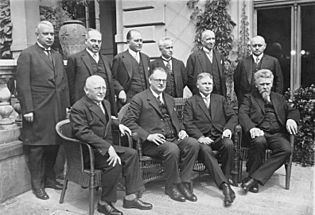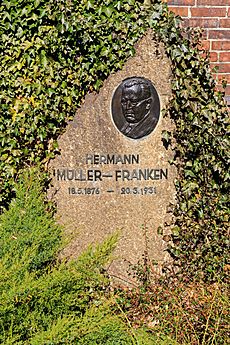Hermann Müller (politician, born 1876) facts for kids
Quick facts for kids
Hermann Müller
|
|
|---|---|

Müller in 1928
|
|
| Chancellor of Germany (Weimar Republic) |
|
| In office 28 June 1928 – 27 March 1930 |
|
| President | Paul von Hindenburg |
| Preceded by | Wilhelm Marx |
| Succeeded by | Heinrich Brüning |
| In office 27 March 1920 – 21 June 1920 |
|
| President | Friedrich Ebert |
| Deputy | Erich Koch-Weser |
| Preceded by | Gustav Bauer |
| Succeeded by | Constantin Fehrenbach |
| Foreign Minister of Germany | |
| In office 21 June 1919 – 26 March 1920 |
|
| President | Friedrich Ebert |
| Chancellor | Gustav Bauer |
| Preceded by | Ulrich von Brockdorff-Rantzau |
| Succeeded by | Adolf Köster |
| Member of the Reichstag (Weimar Republic) |
|
| In office 1920–1931 |
|
| Constituency | Franken 29 |
| (German Empire) | |
| In office 1916–1918 |
|
| Constituency | Breslau 11 |
| Member of the Weimar National Assembly | |
| In office 6 February 1919 – 21 May 1920 |
|
| Constituency | Breslau |
| Personal details | |
| Born |
Hermann Müller
18 May 1876 Mannheim, German Empire |
| Died | 20 March 1931 (aged 54) Berlin, Weimar Republic |
| Political party | SPD |
| Spouses |
|
| Children | 2 |
Hermann Müller (born May 18, 1876 – died March 20, 1931) was an important German politician. He was a member of the Social Democratic Party (SPD). Müller served as the foreign minister from 1919 to 1920. He also became Chancellor of Germany two times. These were during the Weimar Republic, from 1920 and again from 1928 to 1930.
Müller joined the SPD in 1893 and quickly became a leader. He was elected to the Reichstag (Germany's parliament) in 1916. Later, in 1919, he joined the Weimar National Assembly. As foreign minister, he was one of the German officials who signed the Treaty of Versailles in 1919. This treaty officially ended World War I.
During his first time as chancellor in 1920, Müller's government introduced many helpful social reforms. His government had to resign after the SPD did not do well in the 1920 election. His second time as chancellor was from 1928 to 1930. He led a "grand coalition" government, which means it included several different political parties. This period was difficult due to money problems and international issues. The coalition broke apart when the Great Depression started. Müller was already in poor health and passed away a year after leaving office.
Contents
Early Life and Education
Hermann Müller was born on May 18, 1876, in Mannheim, Germany. His father, Georg Jakob Müller, sold sparkling wine. His mother was Karoline Vogt. Hermann went to grammar school in Mannheim and later in Dresden.
When his father died in 1892, Müller had to leave school. His family faced money problems. He then started an apprenticeship in Frankfurt. He worked in Frankfurt and Breslau. In 1893, he joined the Social Democratic Party of Germany (SPD). Müller was the only German chancellor who did not belong to any religion. This was partly because his father was interested in the ideas of a philosopher named Ludwig Feuerbach.
Political Journey
Joining the SPD and the Reichstag (Before 1918)
From 1899 to 1906, Müller worked as an editor for a socialist newspaper. He was also a member of the city council in Görlitz. In 1906, he became a member of the national SPD board. Müller became a centrist in the party. This meant he tried to find a middle ground between different groups.
Müller was known for being calm, hardworking, and honest. He was also very logical. In 1909, he helped create a special committee within the SPD. This committee was set up to handle arguments between different party meetings.
Because he spoke foreign languages, Müller represented the SPD at international meetings. These meetings were for socialist parties from different countries. In July 1914, just before World War I began, Müller went to Paris. He tried to agree with French socialists on how to deal with war loans. But they could not reach an agreement.
During World War I, Müller supported a political truce in Germany. This truce meant that political parties would work together during the war. He was elected to the Reichstag in 1916. He supported the harsh Treaty of Brest-Litovsk with Russia. He also supported the SPD joining the government in October 1918. This happened because the army leaders wanted to make the government more democratic. They hoped this would help them get better peace terms from the Allies.
Revolution and New Parliament (1918 to 1919)
During the German Revolution of 1918–1919, Müller was part of a council in Berlin. He believed Germany should have elections for a new national assembly. This was different from more radical members who wanted a "council republic." He later wrote a book about his experiences during the revolution.
In January 1919, Müller was elected to the Weimar National Assembly. This assembly was Germany's temporary parliament. Its job was to write a new constitution. In February, Friedrich Ebert became president of Germany. Müller then became a co-chairman of the SPD. He focused on representing the party to the public. He also led the SPD in the Weimar National Assembly and later in the Reichstag. In 1920, he won a seat in the Reichstag for Franconia. He then added "-Franken" to his name to avoid confusion with other members named Müller.
First Time as Chancellor (1920)
After the previous leader resigned in June 1919, Müller was asked to become head of government. He said no at first. But he did become foreign minister on June 21, 1919. In this role, he went to Versailles and signed the Treaty of Versailles for Germany.
After another government resigned in March 1920, Müller accepted the offer to become chancellor. He formed a new government with the SPD, German Democratic Party (DDP), and Centre Party. This was known as the Weimar Coalition.
Under Müller's leadership, the government stopped left-wing uprisings. They also worked to disarm private citizen defense groups. His time as chancellor saw many new social reforms:
- A system was set up to help people disabled by war.
- Employers had to hire Germans with disabilities.
- A common four-year primary school course was started for all children.
- Benefits for unemployed people were improved.
- Civil servants (government workers) received better pay.
- A national office was created to help people find jobs.
- Accident insurance was improved for war-wounded people.
- Laws were passed to help young people with disabilities get jobs.
- A law was made to encourage people to own their own homes.
- Rules were put in place to protect tenants from unfair rent increases.
- Orders were introduced to protect women working in dangerous jobs.
Müller was chancellor for only a few months, until June 1920. The SPD lost many votes in the election that year. A new government was then formed without the SPD. Müller was disappointed and did not push hard for a new coalition. He also did not want to work with the German People's Party (DVP). He thought they only cared about business interests.
SPD in Opposition and Coalitions (1920 to 1928)
The SPD was now in opposition. This meant they were not part of the government. But they supported the government's foreign policy. Müller believed Germany should join the League of Nations. He also thought Germany should become closer to Western countries. He did not like the Soviet Union's government.
Müller warned against expecting too much economic help from the Soviet Union. He thought only the United States could truly help Europe rebuild after World War I.
The SPD joined the government again in 1921-1922. Müller, as parliamentary leader, wanted higher taxes on wealth. This caused disagreements with other parties. The SPD left the government again in November 1922. They did not join another government until August 1923.
In 1923, France took over the Ruhr region of Germany. Also, inflation got out of control. Müller saw this as a national emergency. He brought the SPD into a "grand coalition" government. This government was led by Gustav Stresemann. But there were still many disagreements. The SPD left the coalition again in November 1923.
During their time in opposition, the SPD supported making peace with Western countries. They supported the Locarno Treaties and Germany joining the League of Nations. The SPD did not join a government again until June 1928.
Second Time as Chancellor (1928 to 1930)

The SPD won many seats in the May 1928 elections. Müller became the SPD's choice for chancellor. President Paul von Hindenburg agreed to Müller. It took some time to form a government because parties disagreed. But on June 28, 1928, Müller formed his second cabinet. It was a "grand coalition" of several parties.
This government faced many challenges. There were arguments over building a new warship. There was also a big labor dispute called the Ruhr iron dispute. Despite these problems, Müller and Foreign Minister Stresemann worked well together.
Müller's government worked to reduce Germany's war debt. They negotiated with the Allies. By January 1930, they had successfully reduced the payments (the Young Plan). The Allies also promised to remove their troops from the Rhineland by May 1930.
Müller's government also dealt with problems with Poland and the Soviet Union. The middle-class parties in the coalition started looking for ways to end it. Müller also became very ill and could not work for several months.
When he returned, Müller was weaker. The coalition finally broke apart over budget issues. The Great Depression had started, and many people were unemployed. The unemployment insurance system needed more money. The parties could not agree on how to get it. Müller was willing to compromise, but the SPD group in parliament refused. President Hindenburg would not give Müller's government special emergency powers. So, Müller and his cabinet had to resign on March 27, 1930.
During Müller's last government, several important reforms were made:
- A national unemployment insurance system was created in 1928.
- Midwives and musicians became part of a pension plan in 1929.
- Accident insurance was expanded to cover more work-related illnesses.
- A special pension was introduced for unemployed people aged 60.
Later Life and Death
After resigning as chancellor, Müller stepped away from public life. In September 1930, the Nazi Party gained many votes in elections. Müller asked his party to support the new government, even if they were not part of it.
Hermann Müller passed away in Berlin on March 20, 1931. He died after a gallbladder operation. His death was a big loss for the Social Democrats. He is buried in Berlin at the Zentralfriedhof Friedrichsfelde.
Family Life
In 1902, Hermann Müller married Frieda Tockus. They had a daughter named Annemarie in 1905. Sadly, Frieda died a few weeks later due to problems from the pregnancy.
Müller married again in 1909 to Gottliebe Jaeger. Their daughter Erika was born the next year.
Images for kids
See also
 In Spanish: Hermann Müller para niños
In Spanish: Hermann Müller para niños



